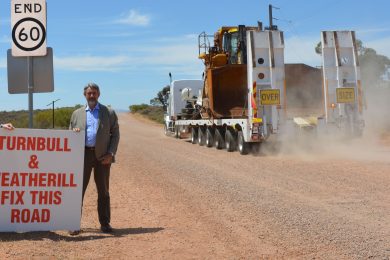One of South Australia’s most influential industry lobby groups has taken the unprecedented step of joining forces with a prominent regional council to pressure the federal and state governments to fund a A$50 million upgrade to a crucial SA road freight route – which links Adelaide to the majority of the country.
In a rare move, the powerful Civil Contractors Federation (CCF) of South Australia has formed an alliance with Port Augusta City Council to call on both governments to commit to funding an upgrade of Yorkey Crossing near Port Augusta.
State development in SA’s north is being retarded as a direct result of the collective government inaction, the alliance members claim.
Yorkey Crossing is a dirt, 27.5-km ring route around Port Augusta which all oversized vehicles must use to pass through the region as the main bridge thoroughfare through the town cannot accommodate such vehicles.
The ring route is inaccessible after heavy rain forcing hundreds of heavy vehicles a year to be delayed – sometimes for days at a time – before the road is re-opened.
The CCF and Council are fed up with the “complete and utter inaction” of both the federal and state governments over many years.
The alliance members accuse both governments of “virtually ignoring” one of the most strategically important freight corridors in the nation and promoting an expansion of the tourism, defence, mining, and oil and gas sectors in the north of the state.
They believe upgrading and bitumizing Yorkey Crossing Road – at a cost of A$50 million – will provide a long overdue, safe and seamless all-weather freight corridor around Port Augusta.
Comments attributable to Phil Sutherland, Chief Executive Officer, CCF: “The SA Government is relying on a traffic survey conducted six years ago as an excuse not to seal Yorkey’s. It’s ridiculous. Traffic has not only increased, but vehicles are now larger and heavier. Also, the number of military vehicles using the road has grown with the expansion of the Cultana Military Base, which has doubled in size in recent years.
“The only way we are going to see a substantial expansion of the resources sector in South Australia is to give that sector a reliable, all-weather freight corridor. Other sectors also need a reliable freight corridor to get their product to market.
“Traffic movement to and from the Cultana Military Base will increase commensurate with the growth of the defence sector in Australia. If an enemy invaded Australia somewhere on Eyre Peninsula, our defence forces would struggle to get their tanks to the battlefield if it was raining.
“Any way you look at the situation, we have a trifecta of grossly inadequate strategic transport infrastructure. In bad weather, the entire northern gateway in and out of South Australia is closed.
“We simply cannot comprehend that fixing this mess is not a priority for the state and/or federal governments.
“It beggars belief that the bureaucratic powers-to-be – sitting in their luxurious CDB offices – can’t see the economic case that can be made for upgrading Yorkey Crossing to an all-weather road. The road as it stands is a dirt track that turns into a quagmire when it rains.”
Comments attributable to Sam Johnson, Mayor of the Port Augusta City Council: “South Australia is currently branding itself as the doorway to Australia. Unfortunately, with Yorkey Crossing Road we have a glaring example of critically strategic road transport infrastructure that doesn’t measure up to this expectation.
“Our community is quite rightly outraged that we have a strategically important road that is not seen as a priority by both our state government and federal government.
“Port Augusta Council enthusiastically joins with the Civil Contractors Federation in calling for Yorkey Crossing Road to be upgraded and bituminized.
“By putting Yorkey’s on the back burner, all that is being achieved is a false economy.
“The economic return on investment in sealing this road would be significant.
“This would start with the construction phase which would generate much needed jobs and local business activity.
“The completed road would then provide ongoing economic stimulus by giving freight transport operators, and other users, a safe, efficient and all weather transport corridor.”










